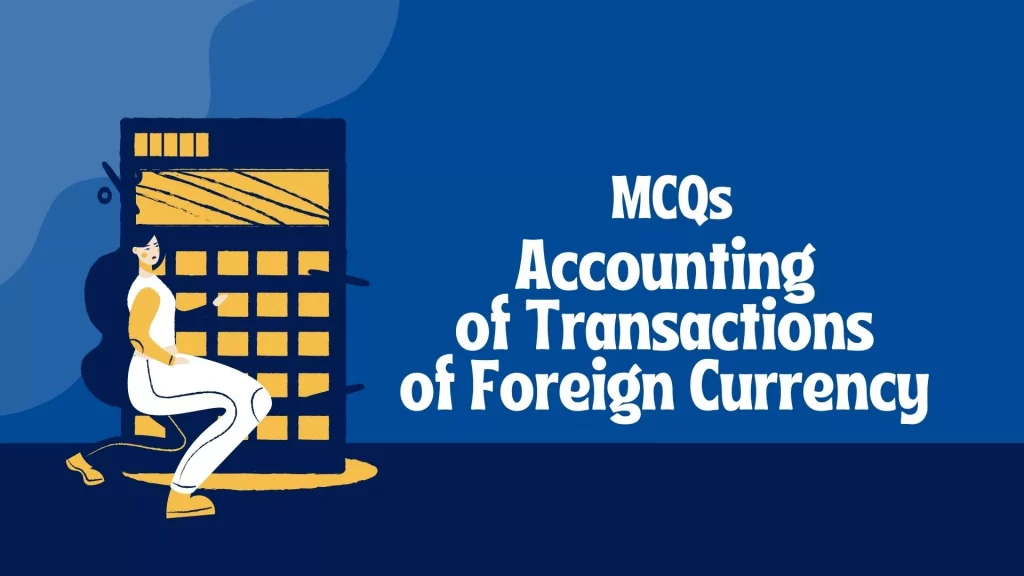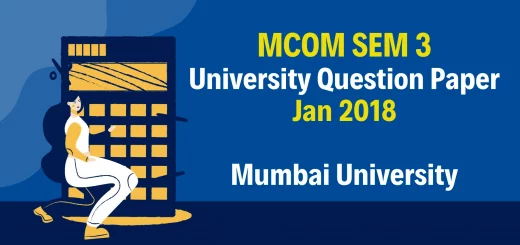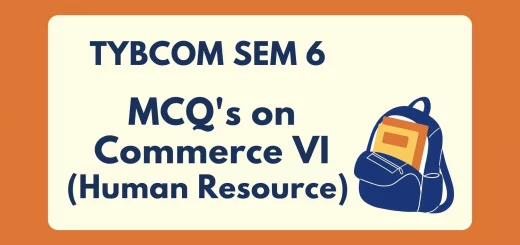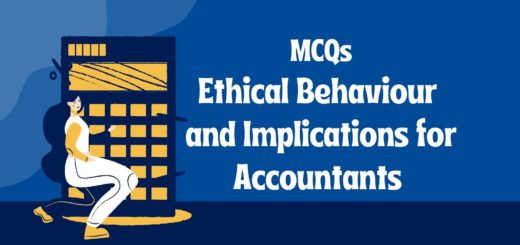Accounting of Transactions of Foreign Currency MCQ | (Free Resource)
Accounting of Transactions of Foreign Currency MCQ

1. Which of the following statements is false?
(a) AS 11 should be applied in accounting for transactions in foreign currencies
(b) AS 11 deals with accounting for foreign currency transaction in the nature of forward exchange contracts
(c) AS 11 specifies the currency in which an enterprise should present its financial statements
(d) The principal issues in accounting for foreign currency transactions are to decide whichexchange rate to use and how to recognize in the financial statements the financial effect ofchanges in exchange rates
2. Average rate
(a) is the exchange rate at the balance sheet date
(b) is the mean of the exchange rates in force during a period
(c) is the ratio for exchange of two currencies
(d) is the rate at which an asset could be exchanged between knowledgeable, willing parties inan arm’s length transaction
3. Closing rate
(a) is the exchange rate at the balance sheet date
(b) is the mean of the exchange rates in force during a period
(c) is the ratio for exchange of two currencies
(d) is the rate at which an asset could be exchanged between knowledgeable, willing parties inan arm’s length transaction
4. Exchange rate
(a) is the exchange rate at the balance sheet date
(b) is the mean of the exchange rates in force during a period
(c) is the ratio for exchange of two currencies
(d) is the rate at which an asset could be exchanged between knowledgeable, willing parties inan arm’s length transaction
5. Currency other than the reporting currency of an enterprise
(a) Non-Reporting currency
(b) U.S. Dollars
(c) Foreign Currency
(d) Indian Rupees
6. Currency used in presenting the financial statements
(a) Reporting currency
(b) Non-Foreign Currency
(c) Official Currency
(d) Indian Rupees
7. Money held and assets and liabilities to be received or paid in fixed or determinable amounts of money
(a) Current items
(b) Non-monetary items
(c) Monetary items
(d) Forward Exchange Contract
8. Which of the following is a foreign currency transaction ?
(i) an enterprise buys or sells goods or services whose price is denominated in a foreign currency
(ii) an enterprise borrows or lends funds when the amounts payable or receivable are denominatedin a foreign currency
(iii) an enterprise becomes a party to an unperformed forward exchange contract
(a) only (iii)
(b) all
(c) only (i)
(d) only (ii)
9. A foreign currency transaction should be recorded, on initial recognition
(a) in the reporting currency, by applying to the foreign currency the exchange rate between thereporting currency and the foreign currency at the date of the recognition
(b) in the Indian Rupees, by using the exchange rate between the Indian Rupee and the U.S.Dollars at the date of the transaction
(c) in the reporting currency, by applying to the foreign currency amount the exchange rate between the reporting currency and the foreign currency at the date of the transaction
(d) in the reporting currency, by applying to the foreign currency amount the average exchange rate between the reporting currency and the foreign currency during the financial year
10. Which of the following statements is false?
(a) At each balance sheet date, foreign currency monetary items should be reported using theclosing rate
(b) At each balance sheet date, non-monetary items which are carried in terms of historical costdenominated in a foreign currency should be reported using the exchange rate at the date ofthe transaction
(c) At each balance sheet date, non-monetary items, which are carried at fair value denominated in a foreign currency should be reported using the exchange rates that existed when the values were determined
(d) At each balance sheet date, foreign currency monetary items should be reported using the average rate during the year
| Answers: 1)AS 11 specifies the currency in which an enterprise should present its financial statements 2)is the mean of the exchange rates in force during a period 3)is the exchange rate at the balance sheet date 4)is the ratio for exchange of two currencies 5)Foreign Currency 6)Reporting currency 7)Monetary items 8)all 9)in the reporting currency, by applying to the foreign currency amount the exchange ratebetween the reporting currency and the foreign currency at the date of the transaction 10)At each balance sheet date, foreign currency monetary items should be reported using theaverage rate during the year |
11. Following is not an example of a monetary item.
(a) Cash
(b) Receivables
(c) Payables
(d) Fixed assets
12. Following is an example of a non-monetary item.
(a) Debtors
(b) Creditors
(c) Bank account
(d) Inventories
13. At each balance sheet date, non-monetary items, which are carried at fair value or other similar valuation denominated in a foreign currency, should be reported
(a) using the exchange rate at the date of the transaction
(b) using the exchange rates that existed when the values were determined
(c) using the closing exchange rate at the date of the balance sheet
(d) using the average exchange rate during the financial year
14. At each balance sheet date, Foreign currency monetary items should be reported
(a) using the exchange rate at the date of the transaction
(b) using the average of the (i) exchange rate at the date of the transaction and (ii) closing exchange rate
(c) using the closing exchange rate at the date of the balance sheet
(d) using the lowest exchange rate during the financial year
15. Following Exchange differences should be recognized as income or as expenses in the period in which they arise –
(a) Exchange difference arising on the settlement of monetary items
(b) Exchange difference arising on reporting an enterprise’s monetary items at rates different from those at which they were initially recorded during the period
(c) Exchange difference arising on reporting an enterprise’s monetary items at rates different from those at which they were reported in previous financial statements
(d) all the above
16. Following Balances should be translated at the closing rate
(a) Non-monetary items valued at historical cost denominated in a foreign currency
(b) Monetary items
(c) Non-monetary items which are carried in terms of fair value, denominated in a foreign currency
(d) All the above
17. Following Balances should be translated at the exchange rate on the date of the original transaction
(a) Non-monetary items valued at historical cost denominated in a foreign currency
(b) Monetary items
(c) Non-monetary items which are carried in terms of fair value, denominated in a foreign currency
(d) All the above
18. Following Balances should be translated at the exchange rate that existed when the values were determined
(a) Non-monetary items valued at historical cost denominated in a foreign currency
(b) Monetary items
(c) Non-monetary items which are carried in terms of fair value, denominated in a foreign currency
(d) None of the above
19. No exchange difference will arise on
(a) inventory, fixed assets, investments etc. valued at historical cost denominated in a foreign currency
(b) cash, debtors or creditors
(c) inventory, fixed assets, investments etc. which are carried in terms of fair value, denominated in a foreign currency
(d) (a) and (c) above
20. The mean of the exchange rates in force during a period is known as
(a) Average Rate
(b) Closing Rate
(c) Reporting Rate
(d) Fair Rate
| Answers: 11)Fixed assets 12)Inventories 13)using the exchange rates that existed when the values were determined 14)using the closing exchange rate at the date of the balance sheet 15)all the above 16)Monetary items 17)Non-monetary items valued at historical cost denominated in a foreign currency 18)Non-monetary items which are carried in terms of fair value, denominated in a foreign currency 19)(a) and (c) above 20)Average Rate |
21. The exchange rate at the balance sheet date is known as
(a) Average Rate
(b) Closing Rate
(c) Non-monetary Rate
(d) Monetary Rate
22. Reporting currency is the currency used
(a) In recording the financial transactions
(b) In presenting the financial statements
(c) In settling the financial transactions
(d) None of the above
23. Foreign currency is a currency
(a) Used in recording the foreign transactions
(b) Used in presenting the foreign financial statements
(c) Other than the reporting currency of an enterprise
(d) Other than the Indian Rupee
24. Non-monetary items
(a) Are the items exchanged at fair value
(b) Are the items other than assets and liabilities
(c) Are assets and liabilities other that monetary items
(d) None of the above
25. Monetary items
(a) Are assets and liabilities to be received or paid in money
(b) Are assets to be received in fixed or determinable amounts of money
(c) Are money held and assets and liabilities to be received or paid in fixed or determinable amounts of money
(d) None of the above
26. An exchange difference results
(a) When there is a change in the exchange rate between the transaction date and the date ofsettlement of any non-monetary items arising from a foreign currency transaction
(b) When there is a change in the fair value rate between the transaction date and the date ofsettlement of any monetary items arising from a foreign currency transaction
(c) When there is a change in the exchange rate between the transaction date and the date ofsettlement of any monetary items arising from a foreign currency transaction
(d) None of the above
27. Non-monetary items which are carried in terms of historical cost denominated in a foreign currency should be reported using the exchange rate at the date of the
(a) Balance Sheet
(b) Transaction
(c) Settlement
(d) None of the above
28. The contingent liability denominated in foreign currency at the balance sheet date is disclosed by using the
(a) Average Rate
(b) Closing Rate
(c) Non-monetary Rate
(d) Monetary Rate
| Answer: 21)Closing Rate 22)In presenting the financial statements 23)Other than the reporting currency of an enterprise 24)Are assets and liabilities other that monetary items 25)Are money held and assets and liabilities to be received or paid in fixed or determinable amounts of money 26)When there is a change in the exchange rate between the transaction date and the date ofsettlement of any monetary items arising from a foreign currency transaction 27)Transaction 28)Closing Rate |


